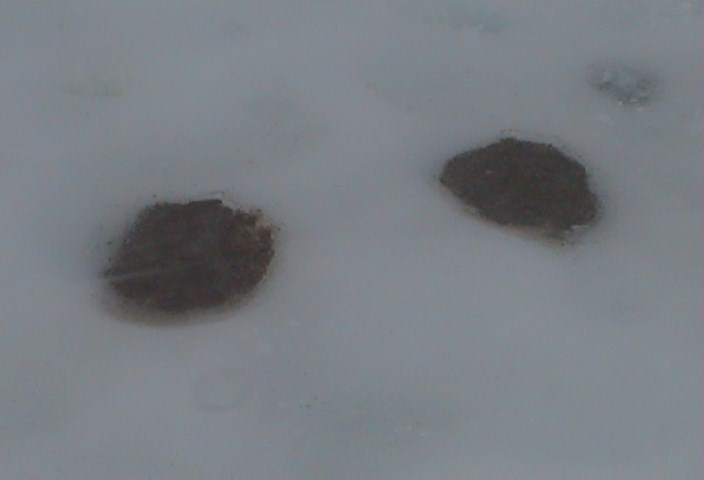Jonathan
Ebnet - Portland State
University
Master's Thesis Research
Master's Thesis Research
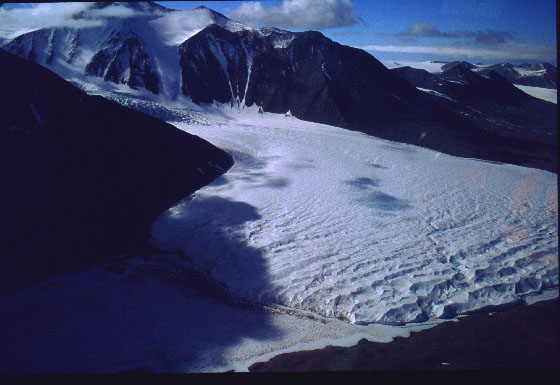
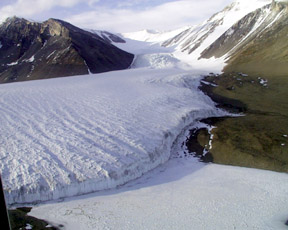
Canada Glacier
with Lake Hoare in the foreground
Canada Glacier with Lake Frxyell in the foreground
Research:
My research involves using an energy balance model to calculate the volume of subsurface melt occurring for glaciers, particularly
Canada Glacier, a polar glacier located in the McMurdo Dry Valleys,
Antarctica. Subsurface melt is important for Canada Glacier and
all the other glaciers present in the dry valleys since air
temperatures, even during the summer months, rarely exceed 0° C, so
little surface melting occurs during the year. During the summer
months, melt-water streams are seen flowing from the base of the
glaciers into perennially ice-covered lakes. Previous energy
balance models of the surface and termini of the glaciers located in
the valley have shown that only 60% of the water present within these
melt-water streams can be accounted for. My research will involve
determining what percentage of the melt-water within the streams is due
to subsurface melt.
particularly
Canada Glacier, a polar glacier located in the McMurdo Dry Valleys,
Antarctica. Subsurface melt is important for Canada Glacier and
all the other glaciers present in the dry valleys since air
temperatures, even during the summer months, rarely exceed 0° C, so
little surface melting occurs during the year. During the summer
months, melt-water streams are seen flowing from the base of the
glaciers into perennially ice-covered lakes. Previous energy
balance models of the surface and termini of the glaciers located in
the valley have shown that only 60% of the water present within these
melt-water streams can be accounted for. My research will involve
determining what percentage of the melt-water within the streams is due
to subsurface melt.How does Subsurface Melt Occur?
Subsurface melting can occur even when air temperatures remain below 0° C by solar radiation penetration through the glacial ice and snow and absorption by ice at depth. The temperatures of the ice at various depths is also dependent upon conduction of heat through the ice from the surface or from ice at greater depths. The flux of solar energy able to penetrate the ice is determined by the surface albedo (the percentage of solar radiation reflected back towards the atmosphere), the properties of the snow/ice such as density, grain size, etc., and the volume of air/water present within the snow/ice. Sediment deposited on top of the glacier can absorb solar radiation and melt into the ice. The sediment can continue to absorb radiation while in the ice, allowing subsurface melting to occur.Preliminary Results
Surface and subsurface energy balance results have been obtained by using a model adapted from the work of Glen E. Liston of the Department of Atmospheric Science, Colorado State University. This model uses meteorological data collected from met stations consisting of air temperature, relative humidity, and wind speed. These measurements are taken from a distinct height above the ground. Through bulk aerodynamic method of energy balance, this model can calculate ice temperatures at various depths, the water fraction at various depths, and the depth of water present beneath the surface. Other measurements obtained from the met stations including the incoming short-wave radiation and albedo have been implemented to obtain more precise results. This model can also calculate the energy balance budget for sediment deposited on the surface of the glacier, particularly for cryoconite holes. Field experiments of measuring ice temperatures with thermistors, ice density measurements, and solar radiation measurements at depth will be used to obtain the accuracy of the model.
Cryoconite Holes
Cryoconite holes are water filled holes caused by increased melting around sediment. Cryoconite holes are common on the surfaces of glaciers in polar and non-polar regions (in polar regions, cryoconite holes have an ice lid, while in non-polar regions, cryoconite holes are open to the atmosphere). Cryoconite holes are not limited to glaciers. Cryoconite holes are also found on lake ice and sea ice. I will investigate whether sediment is required to initiate melt in the subsurface of a glacier, or whether absorption of solar radiation by clean ice is only needed to allow melting to occur. Previous studies have shown that some cryoconite holes are interconnected by cracks within the ice, while the remainder are isolated. These cracks appear to be the means by which the subsurface melt exits the glaciers, discharges into the melt-water streams, and empties into the perennially ice-covered lakes.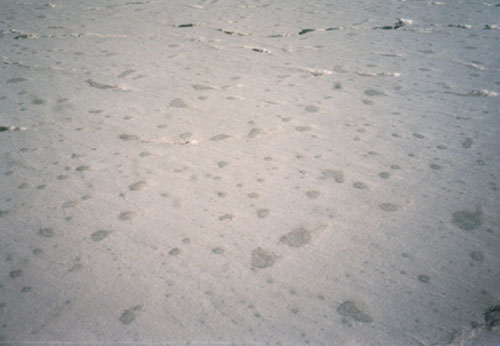
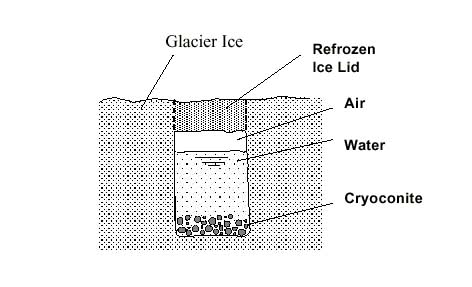
Cryoconite holes located on the surface of a glacier in the dry valleys Cross-section of a cryoconite hole in a polar glacier
Click on the image below to view the evolution of two cryoconite holes over a 41 hour period. Watch how quickly the sediment melts down into the ice, and how fast the hole ices over. The movie will show the ice lid thickening and the hole filling up with air, half way through the movie (visible as the hole becoming lighter in color).
